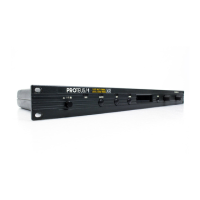PROGRAMMING BASICS
31Proteus operation manual
level
key
down
key
released
AHR
time
If the key is released during the Hold (H) phase, the Release (R) phase begins.
LOW FREQUENCY OSCILLATORS (LFOs)
A Low Frequency Oscillator is simply a wave which repeats at a slow rate.
The Proteus has two multi-wave LFOs for each of its 32 channels. The LFO
waveforms are: Triangle, Sine, Square, Sawtooth, and Random, which is
a random “sample and hold” type of wave.
By examining the diagram of the LFO waveforms, you can see how the
LFO will affect a modulation destination. Suppose we are modulating the
pitch of an instrument. The sine wave looks smooth, and will smoothly
change the pitch. The square wave changes abruptly, and will abruptly
change the pitch from one pitch to another. The sawtooth wave smoothly
decreases, then abruptly changes back up. The sound’s pitch will follow
the same course. Controlling the pitch of an instrument is an easy way to
hear the effects of the LFO waves.
Triangle
Square
Sine
Sawtooth
Random
AHDSRS and LFOs

